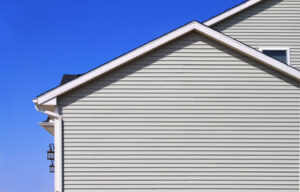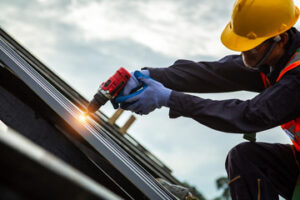Repairing siding can add significant curb appeal and increase your home’s resale value. But ignoring small issues can lead to bigger problems that require more time and money to fix.

If you spot any damage, consult with a professional to find the right solution. Common tools and materials include vinyl patch kits, replacement siding panels, caulk, and color-matching exterior paint. Contact Siding Repair Charleston SC for professional help.
Cracks and holes in vinyl siding can be repaired with vinyl adhesive caulk. Apply a pea-size amount of caulk to the surface of the damaged panel, then smooth it with a putty knife and allow to dry. After the caulk has cured, sand the spot to recreate its original texture and stain or paint as needed to match the rest of the siding.
Larger holes in vinyl siding need to be addressed using a different technique. Start by locating the point of damage and measuring the size of the hole. You will need this information to order a replacement panel from the manufacturer and make sure it will fit properly. If the hole is in a corner, measure the length of the corner of the wall and add a few inches for error. You may also be able to find a scrap piece of the same material and simply glue it into place.
If the damaged section of vinyl is loose, use a utility knife to widen the crack slightly, creating a V-shaped groove. This will help to prevent the new vinyl patch from pulling away from the rest of the damaged panel. Apply a bead of vinyl adhesive caulk along the edge of the groove and press the edges together, ensuring a snug fit.
Board and batten wood siding is more difficult to repair than vinyl, but it is not impossible. If a significant portion of the wood is damaged, it can be replaced by tracing its shape onto a new piece of wood and cutting out the shape with a jigsaw or a slightly larger hole saw. Then nail the new piece into place with stainless steel ring-shank nails.
Although minor damage like cracks and holes can often be repaired with DIY tools, it is sometimes necessary to call in a professional vinyl siding repair expert. These professionals have the skill set, specialized tools and expertise to ensure a durable and visually appealing vinyl siding repair. They can also advise you on whether the damage is extensive enough to justify a siding replacement rather than a repair.
Loose Panels
Unlike cracks and holes, which are easily repaired with the right tools, loose panels require professional attention. They can allow rain to seep behind them, leading to mildew, mold, and rot. They also leave your home vulnerable to the elements and make it harder for insulation to keep draughts out. These problems often occur in places that are hard to spot, such as corners and edges of your siding.
Loose panels are typically caused by wind, but improper installation can also play a role. While powerful winds are the most common cause of this issue, if you notice signs of loose siding on your home, it’s important to have them fixed as soon as possible to prevent further damage.
To fix a loose panel, first inspect the area for other issues such as rot or dry rot, which may be contributing to the problem. Then clean the exposed area to remove any dirt, debris, and old caulking. This step is vital for ensuring that your patch will hold up well over time.
Next, use a zip tool to separate the damaged panel from the one above it. It’s a handy tool that essentially acts as a hook to help you get into tight spots. You can then cut the loose section of siding from top to bottom, making sure not to cut the panel above it. You can then use a nail gun or screws to secure the new piece of vinyl, pushing up on it to lock it into place.
If the new panel is a different color than the surrounding siding, paint it using a caulk designed for this purpose to match up your siding. Then, re-caulk around the patch to ensure that it will be weatherproof. For best results, always use high-quality materials for these repairs to ensure they hold up over time. Then, regularly inspect your siding for any further issues that may need addressing to help keep your home looking its best!
Warping and Buckling
If your siding is looking wrinkly or warped, it could be due to a few things. Most people believe that extreme weather conditions like intense heat and cold or contrasting summer and winter temperatures are responsible for siding warping. The truth is that buckling and warping has less to do with the environment and more to do with poor installation and material quality. This is a common problem with low-quality vinyl siding. The solution is to choose high-quality, weatherproof siding materials that will stand up to the elements.
Generally, minor warping can be fixed by warming up the vinyl with a heat gun and then reshaping it to its original shape. This is a great way to restore the look of your home without spending money on new siding.
For more serious damage, however, you will need to remove the affected panels and replace them. Ensure that the replacement panels match in color and texture to preserve a consistent appearance. If the entire area of your home has been damaged by warping, it is likely time to consider replacement for a more long-lasting and durable option like James Hardie fiber cement siding.
Loose and wavy siding is also cause for concern, as it may indicate that there are structural issues with the walls or foundation of your home. These problems should be addressed promptly, as they can lead to further deterioration of the exterior of your home, as well as moisture and mold issues in the interior.
While some siding repairs are possible as DIY projects, it is always a good idea to call in a professional for extensive or complex repair work. It is also a good idea to contact a professional when you suspect that the problem is caused by underlying structural issues, such as building movement or foundation shifting. A professional can provide a diagnosis of the root cause and ensure that the issue is repaired properly, preventing further damage to your home. In addition, a professional will be able to ensure that the proper installation practices are used and that the proper support system is in place for your siding.
Complex Repairs
A well-maintained home with attractive siding and fencing adds value to a property and provides protection, insulation, and comfort for its residents. However, like any part of your house, siding can suffer damage over time from the elements and everyday wear and tear. It is important to regularly inspect and address any damaged areas to prevent more serious issues in the future.
Minor repairs and a fresh coat of paint can often correct simple issues in siding. However, some damages require the help of a professional to ensure that your home maintains its beauty and functionality. Recognizing when it’s time to call in the experts can help you save money and avoid expensive repairs later on.
While many DIYers are able to handle basic repair projects, a professional can ensure your home is in good condition for the long term. They can evaluate your property to determine whether repairs are needed or if replacement is a better option, as well as recommend any additional services that may improve your home’s energy efficiency.
Complex repairs in siding are typically the result of extensive damage from weather exposure or other factors that cannot be addressed by the typical homeowner. A professional can help you restore your siding to its original condition by using high-quality caulking and patching materials that are designed for fiber cement, ensuring a seamless blend.
Fixing Loose Panels
Loose panels are a common siding problem and usually caused by wind or improper installation. Replacing these panels can be done in most cases by removing the old panel, cutting a new piece to match the length of what was removed, and then attaching it to the adjacent panel with a zip tool or galvanized nails or screws that are appropriate for your siding type.
Before beginning any siding repair project, it’s important to gather the necessary tools and materials to complete the task. A utility knife, a zip tool, a pry bar, and a hammer are commonly used for this type of work. It is also recommended to have a ladder that is stable and positioned on solid ground for safety purposes. A ladder that is too low or unstable could tip over, resulting in injury. Once the repairs are completed, it’s vital to seal and paint the area to protect it from moisture intrusion and keep it looking smooth and clean.








